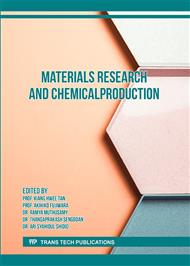[1]
G.M. Goodwin, Application of strain analysis to sheet metal forming problems in the press shop, Metall Ital. 60(1968)764-774.
Google Scholar
[2]
S.P. Keeler, Determination of forming limits in automotive stampings, Sheet Met Ind. 42(1965) 683-691
DOI: 10.4271/650535
Google Scholar
[3]
Z.Chen, G.Fang, J.Q. Zhao, Formability evaluation of aluminum alloy 6061-T6 sheet at room and elevated temperatures, J. Mater. Eng. Perform. 26(2017) 4626-4637.
DOI: 10.1007/s11665-017-2895-0
Google Scholar
[4]
A.M. Beese, M.Luo, Y.Li, Y.Bai, Partially coupled anisotropic fracture model for aluminum sheets. Eng. Fract. Mech.77(2010)1128-1152.
DOI: 10.1016/j.engfracmech.2010.02.024
Google Scholar
[5]
J.H. Han, J.Y. Suh, K.K. Jee, & J.C. Lee, Evaluation of formability and planar anisotropy based on textures in aluminum alloys processed by a shear deforming process, Materials Science and Engineering: A. 477(1-2) (2008)107-120.
DOI: 10.1016/j.msea.2007.04.117
Google Scholar
[6]
P. Petroušek, , R. Kočiško, T. Kvačkaj, R. Bidulský, J. Bidulská, A. Fedoriková, and P. Sabol, Formability evaluation of aluminium alloys by FLD diagrams, Acta Physica Polonica A. 131:5 (2017)1344-1346.
DOI: 10.12693/aphyspola.131.1344
Google Scholar
[7]
Zhang Wei. "Rolling, partial and full annealing of 6061 characterization of microstructure, tensile strengths and ductility, Materials Sciences and Applications. 7:9 (2016) 453-464.
DOI: 10.4236/msa.2016.79040
Google Scholar
[8]
R Narayanasamy, N. L. Parthasarathi, Effect of annealing on formability of aluminium grade 19000,Materials & Design. 29:8 (2008)1633-1653.
DOI: 10.1016/j.matdes.2006.12.019
Google Scholar
[9]
H. Takahashi, H. Motohashi, S. Tsuchida, Development of plastic anisotropy in rolled aluminium sheets, International Journal of Plasticity.12:7(1996)935-949. doi.org/.
DOI: 10.1016/S0749-6419(96)00035-6
Google Scholar
[10]
V.K. Barnwal, A. Tiwari, K. Narasimhan,S. Mishra, Effect of plastic anisotropy on forming behavior of AA-6061 aluminum alloy sheet,The Journal of Strain Analysis for Engineering Design.51:7 (2016)507-517.
DOI: 10.1177/0309324716655727
Google Scholar
[11]
S.S. Hecker, Formability of aluminum alloy sheets, J. Eng. Mater. Technology. 97:1 (1975) 66-73
DOI: 10.1115/1.3443263
Google Scholar
[12]
F. Stachowicz, Formability of aluminium-alloy sheets, Journal of Mechanical Working Technology. 13:2(1986) 229-235.
DOI: 10.1016/0378-3804(86)90068-9
Google Scholar
[13]
D.C. Chen, C.S. You, F.Y. Gao, Analysis and Experiment of 7075 Aluminium Alloy Tensile Test, Procedia Engineering. 81(2014)1252-1258.
DOI: 10.1016/j.proeng.2014.10.106
Google Scholar
[14]
W.Chen, M.Chen, X. Jin, P.Zang, Effect of heating rate during annealing on microstructure and texture evolution of AA8021 aluminum foil, Materials Research Express. 7:9 (2020)1-10.
DOI: 10.1088/2053-1591/abb7ab
Google Scholar
[15]
S. Feliks, Formability of aluminium-alloy sheets, Journal of Mechanical Working Technology. 13-2 (1986):229-235.
DOI: 10.1016/0378-3804(86)90068-9
Google Scholar
[16]
Q.B.Yu, X.H Liu, D.L. Tang, Extreme Extensibility of copper foil under compound forming conditions. Sci. Rep.3(2013) 3556. https://doi.org/10.1038/srep03556 (2013).
DOI: 10.1038/srep03556
Google Scholar
[17]
Z.Marciniak, K. Kazimierz, P Tadeusz, Influence of the plastic properties of a material on the forming limit diagram for sheet metal in tension, International Journal of Mechanical Sciences 15:10 (1973)789-800.
DOI: 10.1016/0020-7403(73)90068-4
Google Scholar
[18]
K. Ohashi, H. Utsunomiya, R. Matsumoto, Evaluation of r-value of steels using Vickers hardness test, Journal of Physics: Conference Series 379:1 (2012) 012045.
DOI: 10.1088/1742-6596/379/1/012045
Google Scholar
[19]
J. Shen, B. Chen, J.Wan, J. Shen, J. Li, Effect of annealing on microstructure and mechanical properties of an Al–Mg-Sc-Zr alloy, Materials Science and Engineering: A 838 (2022) 142821.
DOI: 10.1016/j.msea.2022.142821
Google Scholar
[20]
R.Narayanasamy, R., et al. "A crystallographic texture perspective formability investigation of aluminium 5052 alloy sheets at various annealing temperatures, Mater. & Design.30:5 (2009)1804-17
DOI: 10.1016/j.matdes.2008.09.011
Google Scholar
[21]
X. Fang, G. He, M. Ruiz, C. Zheng, Y. Wang, Z. Li, Y. Zhu, Influence of annealing parameters on the mechanical properties of heterogeneous lamella structured 5083 aluminum alloy." Letters on Materials. 9:4s(2019) 556-560.
DOI: 10.22226/2410-3535-2019-4-556-560
Google Scholar
[22]
X. Chu, L. Leotoing, D. Guines, E. Ragneau, Temperature and strain rate influence on AA5086 Forming Limit Curves: Experimental results and discussion on the validity of the MK model, International Journal of Mechanical Sciences. 78 (2014)27-34
DOI: 10.1016/j.ijmecsci.2013.11.002
Google Scholar
[23]
S.Mahabunphachai, M. Koç. "Investigations on forming of aluminum 5052 and 6061 sheet alloys at warm temperatures, Materials & Design.31:5 (2010)2422-2434.
DOI: 10.1016/j.matdes.2009.11.053
Google Scholar
[24]
J.I. Hamada, K. Agata, and H. Inoue, Estimation of planar anisotropy of the r-value in ferritic stainless steel sheets, Materials transactions. 50:4 (2009)752-758
DOI: 10.2320/matertrans.MRA2008399
Google Scholar
[25]
F.Djavanroodi, A. Derogar, Experimental and numerical evaluation of forming limit diagram for Ti6Al4V titanium and Al6061-T6 aluminum alloys sheets, Materials & Design. 31:10 (2010) 4866-4875.
DOI: 10.1016/j.matdes.2010.05.030
Google Scholar
[26]
S.K. Mishra, S.G. Desai, P. Pant, K. Narasimhan, I.Samajdar, Improved predictability of forming limit curves through microstructural inputs, International Journal of Material Forming 2:1(2009)59-67.
DOI: 10.1007/s12289-009-0391-2
Google Scholar
[27]
C. Cui, Y. Li, F.Wang, B. Jiao, L. Huang, W. Zhang, L.Zhou, Texture evolution and mechanical anisotropy of cold-rolled Zr-4 alloy tube after recrystallization annealing, International Journal of Refractory Metals and Hard Materials. 110 (2023) 106048.
DOI: 10.1016/j.ijrmhm.2022.106048
Google Scholar
[28]
A. Rouzbeh, M. Sedighi , R. Hashemi, Effects of strain path on the microstructure, tensile properties, and formability of Al/Mg roll-bonded sheets, Journal of materials Research & Tech.23 (2023)5318-5328.
DOI: 10.1016/j.jmrt.2023.02.148
Google Scholar



